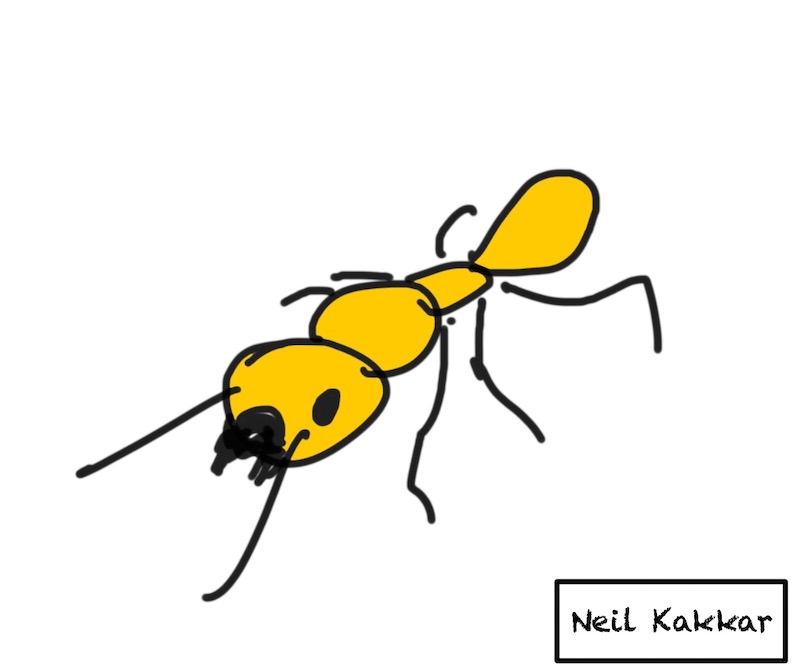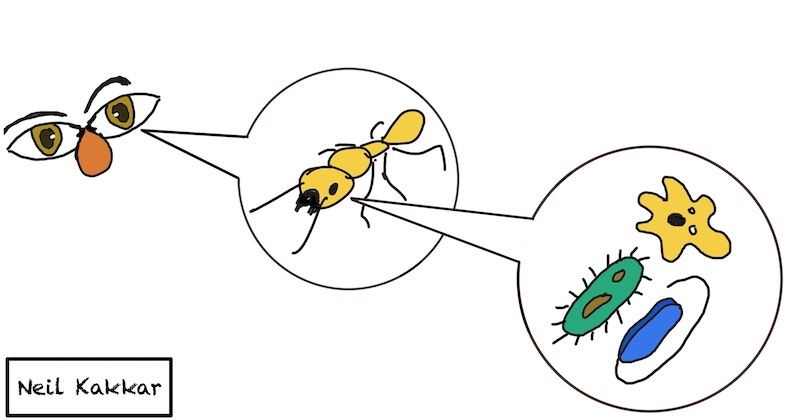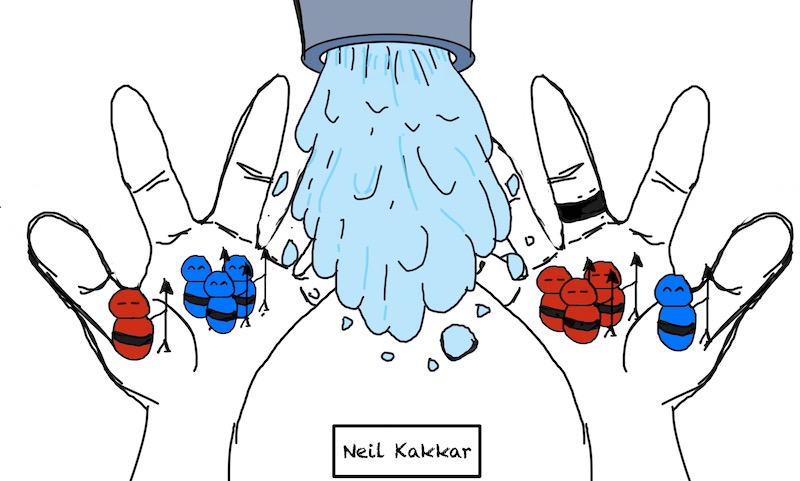Germs are small, sticky, and omnipresent
The Apollo 11 astronauts spent 3 weeks in quarantine after returning to Earth. That’s because we didn’t know if moon germs existed. More than that, we didn’t know if moon germs could kill everyone on Earth. No matter how small the probability, the risk was big enough to enforce the quarantine. Scientists at NASA played it extra-safe.
Since we can’t see them, we don’t pay much attention to them. There’s nothing to pay attention to. The scale is different and we have trouble imagining it. This leads to some pretty incorrect ideas of how germs work.
I was worried about this. I didn’t understand how germs work. When I blow food that falls on the floor, do I get rid of germs? Why not? How does my mobile phone get dirtier than a toilet seat? Why don’t I get sick travelling in the tube everyday? I touch the same bar hundreds of other people do. How do germs transfer from anything I touch to my hands? Same for the food that fell? Is the three second rule valid?
I’ve found some answers.
First, let’s build some intuition for how small germs are, and how to think like a germ. It’s almost impossible for us to close the distance: how do we even go about seeing something that is invisible to our eyes, let alone thinking like that? We’ll use a technique from fractal mathematics called iterated function systems.
What’s the smallest animal we can see and observe? The small ants and spiders. Let’s take a small Pharaoh ant, Antoine.

It’s interesting how Antoine the ant can climb walls in your house that you can’t. Where does it get the grip from?
Let’s zoom out a bit. What can we climb? Rocks and mountains. It’s easier to figure out the grips and use our hands and feet to climb. Antoine climbing the house wall is just like us climbing Mt. Fuji.1
If you zoom in to look through Antoine’s eyes, what it sees is a rock climbing wall as high as Mt. Fuji. What appears smooth to us, is full of footholdings and crevices for Antoine to stick its legs in. This is the important bit: What looks smooth to us, is rough to an ant.
Here’s where the math trick comes in. Once you can see like Antoine, you apply this approximation again. What’s the smallest thing an ant can see?2 What’s a 1000x smaller than the ant? Yep, you guessed it, it’s germs. What appears smooth to Antoine is rough. Very rough. Bacteria find the smallest of places to stick to. Further, at this scale, chemical bonds are strong enough to influence the entire organism. More so, since some organisms are just a single cell.
What do germs look like
Since we’re trying to figure out what Antoine the ant would see, we bring out our electron microscope to figure that out.
Germs come in various sizes and shapes. Most have at least one leg which helps them stick to things.

Now, with intuition for scale and shape on our side, we can dive into the 3 main principles governing germs.
Principle #1: Germs are small, and can stick to almost anything
Once we understand the scale we are dealing with, other things that seem weird become clear.
Just like how Antoine has legs, germs have outgrowths to help them stick to things. Since everything that appears smooth to us looks rough to a germ, it can find a way to grab and stick to things. Keep in mind though, that the way germs grab onto things isn’t always physical. It can be chemical too. That is, instead of grabbing things with a hand, it may stick by forming chemical bonds. The “legs” are created such that bonding to them becomes easy.
Knowing a principle isn’t enough - we want to be able to reason about things using this principle. In such cases, two things help a lot - examples on how to use the principle, and a bit of imagination on what the principle means.
We’ll cover examples later, with all three principles together. So, for now, let’s imagine.
Imagine what would happen if we lived in a world full of glitter. Everything’s covered in glitter. Chances are, everyday you’ll get some glitter on yourself. But, I’d bet your entire body doesn’t gets glitter on it. Some parts will have more glitter than others. For example, there will be no glitter on your elbows and back-sides of the knees. There will be lots of glitter on your hands, and the keyboard you type on, door handles, doors, chairs, water bottles, and glasses. Everything we use everyday, we need our hands to use. Further, we touch our faces more frequently than any other body part, so that would have the second highest glitter concentration.
When we wash our hands, we’ll get most of the glitter off. But that probably wouldn’t last very long. Just after we wash our hands, we’ll be touching the glitter-filled door handle. Maybe even before the door handle, we’ll use the glitter covered towel to dry our hands.
Next, let’s understand where this analogy breaks down. Glitter sticks to surfaces because it’s mixed in with adhesives or glues designed for sticking - making it possible to stick to almost any surface. Germs don’t have this. How then, do germs stick? The outgrowths help stick to any rough surface. But even among surfaces, there are some surfaces where germs stick better. These two forces - affinity and roughness - play together to decide how many germs would transfer from one surface to another. Usually, both surfaces get new germs.
Moist surfaces are a gold mine for germs: the chemical bonds formed on moist surfaces are very strong.
Principle #2: Germs have a lifespan, and are very hard to kill
Some germs die quickly. Others live on for months.
Some die with a drastic change in the environment, like in pasteurization of milk, or antibacterial soap. Others enter a dormant state (something like hibernation in animals)
Washing usually removes them from the surface of your skin, and sends them down the drain - like the glitter. You don’t obliterate it, but transfer it elsewhere.
How would you go about killing a germ? Chances are, you probably can’t. Punching, pinching, or cutting don’t help: Germs are on a different scale. What you can do is wash them away. “Keeping yourself clean” is basically getting rid of germs from the body. Not killing them, but passing them on to the drain.
Of course, if you start using hand-sanitizers or other alcohol based rubs, you can kill germs. That’s why you’re not producing any waste when using the sanitizer - everything is contained in your hands, and you’re hoping all the germs die.
That’s never the case.
Principle #3: Germs procreate rapidly
Like most microorganisms, germs are very quick to procreate. If you thought rabbits were quick, wait till you meet E. Coli. Their population can double in 15 minutes to an hour.
This growth process isn’t endless. The bacteria grow until they start competing for resources. As the resources finish, conditions become sub-optimal, and their growth rate slows down, and the death rate catches up.3
In systems with delays like these, the population oscillates.
Coming back to our glitter, imagine what would happen if we keep transferring glitter from surfaces to our hands - soon enough, there will be no glitter left on things, and it will all end up in the drain. This doesn’t happen with germs. Whenever our hands touch a surface and take away some germs, the other germs procreate to fill up the new space, if the space is habitable.
Another side effect of rapid pro-creation is that they can mutate rapidly too. This leads to quick evolution.
In the link above, notice how crossing the first barrier took so much longer than all the rest. Once the germs got the anti-penicillin gene, further mutations were easier.

Using these three principles, we can explain most situations and build an accurate model for ourselves. Let’s explore one use case, then talk a bit about skin flora and our immune system, and then some more use cases of our model.
Can I eat something that just fell on the floor?
Can I blow away germs?
How is water safe to drink from streams with slimy moss beneath them?
3 questions, and all boil down to Principle #1. Germs are small, and they stick.
When that strawberry touches the floor, it’s going to immediately pick up germs from the floor. There’s no delay in chemical bond formation. These germs are super sticky, and the surface of a strawberry is rough enough that there are “caves” for the bacteria to hide in. Like how cavemen used to protect themselves from the wind, by setting up caves, germs happen to be in caves on the strawberry.
If you try to blow them away, you’ll get rid of some of them, but never all of them.
Does this mean you can’t eat the strawberry? Maybe. We’ll revisit this question after talking about the immune system.
The slimy moss water is interesting. The water is indeed safe to drink. It’s safe because of the moss underneath. This time around, the bacteria / fungi have stuck to the rocks, and filter the water as most germs and other particles get stuck to the moss.
Skin flora and the Immune System
You’re aware of the immune system. The white-blood cells inside our bodies keep us healthy by fighting off germs that make it inside.
However, we have a lively ecosystem of germs on the surface, too. This is the skin flora. Most of these bacteria are harmless, and some are useful for us. Imagine them to be your own army, fighting against foreign germs.
Your super power is flushing away everyone. You’re like a god who has power to bring about massive floods. You don’t distinguish between good and bad, you kill everyone.

Now imagine what happens when you wash your hands. It’s a massive water flood, which cleans off exposed bacteria.
Remember the caves on your hands? Some bacteria survive. Thus, by virtue of Principle #3, these survivors procreate rapidly to again cover your hands.
This is key. The 0.1% that sanitizers can’t kill (for an altogether different reason) stay and bide their time. When conditions turn favourable, they multiply.4
But wait, what about the good germs? The skin flora? Aren’t you washing away those bacteria as well?
Indeed. When your hands are dirty, though, or been to uncharted places, the concentration of dangerous bacteria is higher - so you’ll do okay. Not all good germs are washed away anyway, so they get time to cover your hands again. This is one reason having too many baths can be harmful5 - you’re getting rid of all the good germs, when there are no bad germs to get rid of.
Coming back to the dirty strawberry example, do we know better now? Can we eat it?
I’ll eat it if it’s not moist. I’ll blow to convince myself it’s clean - although that wouldn’t achieve much. However, if I’m worried that the surface it fell on could’ve been contaminated recently - by something my immune system can’t handle - I’ll avoid eating it. This includes other people visiting home, shoe residue, or a surface that hasn’t been cleaned for a week or two. It’s prudent to not take the risk at all, but I don’t like wasting strawberries.
Where do germs grow
Germs are everywhere. Any surface you’ve touched is probably contaminated. In your home, the connection between the outside world and inside is you. Principally, your hands, since they touch the most stuff. Every time you touch something, you’re transferring thousands of germs from that surface to yours. You’re also transferring thousands from your hands to that object. Thus, any surface that isn’t cleaned is bound to have germs.
Let’s take an example that will make things clear: The mobile phone.
Our hands touch lots of things in the environment, hence are full of bacteria. We frequently touch mobile phones, too. 2617 times a day, over 76 sessions, according to this study.
Every time we do, we transfer some bacteria onto our phones. If we were on the toilet beforehand, or anywhere unsanitary, those germs made it onto our phones, too.
Now, how often do you clean your phones? I do it less than once a month. That’s a lot of different germs accumulating on my phone. Given how I live with most of these germs (skin-flora), my immune system is used to them, and it shouldn’t be a problem6. The more significant danger occurs when we pass these germ-pinata boxes around. Other people might be living in different environments with different germs. You use their phones, and given how dirty phones are (they probably don’t clean their phones very often, either), you’re exposed to quite a few new bacteria.
The germ-pinata box of a mobile phone wouldn’t be a problem though, if your phone had a covering of silver. Oligodynamic effect - some metals are antiseptic and kill germs over time. That’s one benefit of the bling, I guess.
The door knob? Same story. You don’t even have to consciously share door knobs, it happens automatically. Brass doorknobs are preferred because of the Oligodynamic effect, too.
These were both found to be dirtier than toilet seats, because toilet seats are cleaned much more regularly, and possibly, there’s no direct germ transfer on the toilet seat.
The tube/metro? Similar story. The contamination depends on how often it’s cleaned. Not surprisingly, people do get sick a lot on the tube.
Handshakes? How clean is the other person’s hand? Did they just come from the restroom? That’s probably the best time to shake hands – if they do wash them.
If you’d like to test your understanding, here’s a list from webMD - can you reason through why they are dirty?
As you might have guessed, there are three main factors to determine how dirty something is. The examples were there to hone your intuition about these.
- How often it’s touched (incoming germs)
- How often it’s cleaned (outgoing germs)
- How suitable is the surface for growth. (germ multiplication rate)
Zooming out, the human population works with the same variables - birth rate, death rate, and environment for growth.
We are in a good place now to tackle every random question about germs.
FAQs
How do germs spread?
The game is touching. They’re sticky, so they’ll stick to almost anything.
They are small, too. So, like Antoine the ant, they can be blown away and carried by the air.
Funnily enough, when you flush the toilet, the force of water is strong enough to blow germs (and water) into the air.
The flush isn’t the only thing sending germs through the air. The average sneeze or cough can send around 100,000 contagious germs into the air at speeds up to 100 miles per hour.
Sneezes are an ideal agent for germ transfer.
How do germs infect?
When they get into the system. i.e when you touch your mouth, eyes, nose with contaminated hands. Most things come from the hands.
What’s the dirtiest body part?
Hands!
How to prevent germs from spreading?
Wash your hands regularly!
This is an underrated superpower. Since most germs infect you via your hands, keeping your hands clean is the most high leverage activity you can do. It’s 80/20ing germ protection.
Also, don’t sneeze on others.
Where do germs grow?
Almost everywhere.
I just washed my hands. How many germs are there now?
I have no idea. It’s not the numbers that matter, but the balance between your immune system and the harmful ones. You want to keep your hand full of skin-flora, the not harmful/beneficial bacteria, so there isn’t enough space and resources for the harmful ones to procreate.
Is it worth keeping everything clean, always?
Probably not. The immune system does well to face problematic germs from time to time. Living in a super clean environment can be harmful.
Here’s a great 6 minute video explaining the immune system.
Raw food in the kitchen. Is it safe to prepare? Can I clean things with a wet cloth?
Raw foods contaminate kitchen surfaces with bacteria, which aren’t killed when you wipe off the counter with a wet cloth or sponge.
The “caves” exist on your kitchen shelf as well, just like your hands. Anti-bacterial wipes might help kill them, but as we know, the best a wet cloth can do is move them someplace else.
Why should I dry myself before wearing clothes?
Wet feet + socks = ideal fungus (germ) growth condition.
But, to grow, fungus needs to be there in the first place. You don’t always get fungal infection because maybe your good bacteria kills it off. Or maybe there’s no place to grow. Or maybe they’re not there. But a day or two later, they might be. You interact with the environment, and the environment interacts with you. And then they find the moist environment. Boom.
Why do you need flu shots every year, but vaccines for measles works forever after childhood?
The answer lies in the mutation speed. The flu virus can mutate and still be effective, thus requiring a new vaccine almost every year.
Measles, on the other hand, can’t mutate and keep their infectious elements, thus requiring only one vaccine during childhood.
Fun fact: WHO comes up with recommendations every year for the strains likely to cause the most suffering, using data on infections from around the world. Then, each country chooses one or more of the strains for their specific country.
What should I remember about germs, always?
Germs are small, sticky, and omnipresent.
Hard to kill but easy to wash away. Easy to wash away most, but never all of them. The ones that get left behind pro-create quickly.
Don’t get paranoid, just ensure your immune system is up to the mark: thanks to a healthy life, good sleep, and good food. And wash your hands.

Thanks to Anya Pearse, Dr. Monisha Baluja Sardana and Dr. Bhavna Dangi for reading drafts of this.
-
Average Pharaoh ant is 2mm in size, average house wall is 2m. So, a 1000x increase. Average human, 1.5m. Mt. Fuji trail goes from 2,300 m to 3,700 m. So, 1,400 m climb. Roughly 1000x, too. However, yes, we don’t climb straight up with Mt. Fuji, but it’s a reasonable rough estimation. ↩
-
Ants can’t see as well as humans, so they wouldn’t see bacteria. The world is not invariant under scale transformations - things change that make analogies difficult. Read more ↩
-
Just like what I expect will happen with the human population over the next 50 years ↩
-
If you didn’t check the link above, sanitizers aren’t very effective. The label that says 99.9% is misleading. ↩
-
Notice how this article hints at the three principles, but is a very surface level treatment. (Pun intended). For example, “washing too often may damage these microorganisms” suggests that they are strong and need a few washes before they die, but now you know better. A wash cleans some of them, and subsequent washes that don’t give them time to grow cleans more of them. You may reach a point where the concentration becomes so low that other germs overpower them. ↩
-
However, if your hand touches a place contaminated with a harmful bacteria, one your immune system can’t handle, you’re bound to get sick. ↩
You might also like
- How to setup duration based profiling in Sentry
- How to simulate a broken database connection for testing in Django
- The "People fuck up because they're not like me" Fallacy
- How I Own Projects as a Software Engineer
